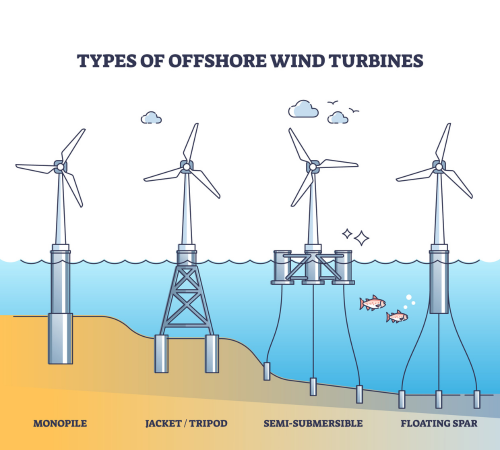New Technology in Renewable Energy: Floating Wind
New technology in renewable energy: Floating Wind
Wind turbines have historically been based on fixed structures on the seabed, floating turbines are installed on platforms flexibly anchored to the seabed.
Quanta have been supporting the emerging technology of floating wind since 2017. The first floating wind turbine was actually installed on a very small scale in 2009 in Norway. But the Hywind project in Scotland is considered the first “real” floating wind project. The 30MW farm has been operational since 2017 and is demonstrating that floating wind farms 10 times larger than this one are feasible.
Opportunities
As this project proves, the potential for floating wind projects is huge with a possible significant number of career opportunities. The roles required will be similar to fixed-bottom wind farms, with the addition of requirements we haven’t seen before due to the floating foundations that are used. From that perspective we will start to see opportunities in hull and mooring engineering and transferable skills from other energy sub-sectors such as Oil & Gas.
Not only will this emerging market provide job opportunities it’s estimated that 12 million European homes could potentially be powered by floating wind by 2030. Especially if Norway have anything to do with it, the country has no precise expansion plans but a recent study found that floating wind could provide as many as 52,000 new jobs in Norway by 2050. With a deal recently being signed for a state-of-the-art floating wind foundation manufacturing facility on Norway’s west coast.
What makes floating wind a better source of power than fixed?
The deepest fixed bottom wind turbines can only be deployed in water depths of 58.6 metres. But the most powerful and consistent winds are found further out at sea where the waters are in the hundreds of metres deep. Due to the nature of the floating foundation these turbines can be towed out further in seas and oceans where wind farms have not been a viable option, opening up markets in places such as the Pacific Ocean – off the coast of California and Japan.
Among the advantages, is less subsea and installation noise, resulting in less disruption to marine life. In fact installation will be quicker and easier as considerable amount of the work will be completed port or quay side.
Challenges
Due to the number of offshore projects in general, the industry is facing a potential skill shortage as well as supply chain issues, for example the availability of steel and fabrication space to produce the monopoles or foundations. Both of these challenges considered a by-product of a booming issue.
Floating wind specific challenges are also something to consider, it’s a new technology and current projects are small scale demonstrations to prove that they can work technologically and commercially.
What does the future hold
But as we know challenges are faced by all new and emerging markets and floating wind isn’t any different but with floating wind potentially allowing us to access up to as much as 80% of the world’s offshore wind resource it could be a real game-changer for energy generation for years to come.
Offshore and onshore wind are the UK’s best hopes in meeting climate targets and securing a sustainable future. Jobs in the industry are only set to grow and at Quanta we are already understanding the pressure our clients are feeling to fill positions in their offshore wind farm builds. Are you interested in moving into an offshore wind job, and want to talk to the experts on how to get there? Contact us at Quanta to start your next career step or check out our offshore wind job vacancies.





.png?v=9c66da852d51be41fe90acf5046b80f7)
.png?v=b063bae722cc20e86f7c80b91426db55)
.png?v=36a90c86dfc9fe9c10b03095e461dfe9)